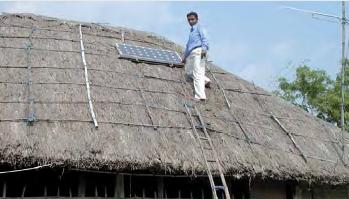Solar Home Systems (SHS)
Solar home systems (SHS) are stand-alone photovoltaic systems. In rural areas, that are not connected to the grid, SHS can be used to meet a household's energy demand fulfilling basic electric needs. SHS usually operate at a rated voltage of 12 V direct current (DC) and provide power for low power DC appliances such as lights, radios and small TVs for about three to five hours a day.
A SHS typically includes one or more PV modules consisting of solar cells, a charge controller and at least one battery for energy storage.
They contribute to the improvement of the standard of living by
- reducing indoor air pollution and therefore improving health as they replace kerosene lamps,
- providing lighting for home study,
- giving the possibility of working at night and
- facilitating the access to information and communication (radio, TV, mobile phone charging).
Furthermore, SHS avoid greenhouse gas emissions by reducing the use of conventional energy ressources like kerosene, gas or dry cell batteries or replacing diesel generators for electricity generation. Further impacts of renewable energies, such as SHS, can be found in the Report on Impacts.
Stand-alone photovoltaic systems can also be used to provide electricity for health stations to operate lamps during night and a refrigerator for vaccines and medicines to better serve the community.
Technical Standards for Solar Home Systems
To assure the quality of a photovoltaic power system and its correct functioning and guarantee costumers' satisfaction, it is important that the components of the system and the system as a whole meet certain requirements.
The GIZ prepared a publication which gives an overview of different standardisation activities and existing standards that are relevant for solar home systems (SHS) and rural health power supply systems (RHS): Technical Standards for SHS.
Planning, Installation and Maintenance of SHS
Before installing a photovoltaic (PV) solar home system (SHS), its size has to be calculated according to different assumptions, such as measurement of solar radiation, solar insolation and power demand. Regarding the installation process, Solar Home Systems have to be installed by a trained technician who knows how to handle its different parts. Thus, aspects of mainentance and a solar technical training manual is presented: Planning, Installation and Maintenance of SHS.
Tools to prevent theft of panels




















